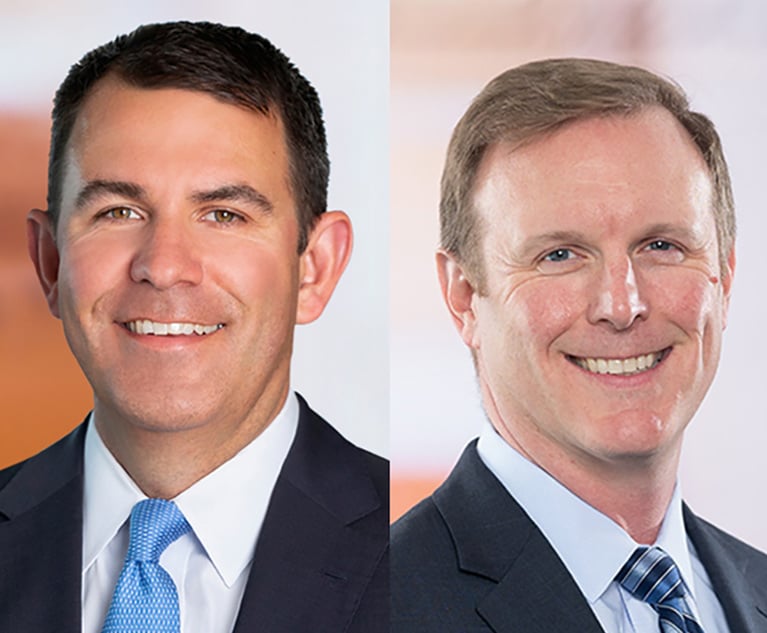Data-Driven Client Retention Program Wins Fans at DLA Piper
The initiative, which uses predictive analytics to help the firm broaden its relationships with existing clients, is now out of its pilot stage.
April 02, 2018 at 03:50 PM
3 minute read

Marketing experts have long pressed lawyers to genuflect at the altar of existing client relationships, arguing that law firms grow faster and more efficiently by expanding their business with the clients they already have.
It's a lesson that hasn't been lost on the marketing team at DLA Piper, which has begun rolling out an ambitious program aimed at helping its lawyers grow their business. The initiative, which the firm first introduced in pilot form last year, uses internal data to address revenue loss from existing clients and reverse those trends.
So far only a fraction of the firm's 3,600 lawyers are participating. But for those that do, the rewards can be great, according to Barbara Taylor, the firm's U.S. chief marketing officer.
To implement the program, DLA Piper's marketing team gathered and analyzed data about its clients, the work that the firm has done for them, the revenues generated as a result, staffing details, and other variables. The firm used that analysis to identify what led to shrinkage or growth in client relationships, and built a predictive model that spells out what actions lawyers can take with specific clients.
Taylor's team identified four actions as the most effective with the most clients: reducing the legal team serving the client to five lawyers or less; introducing a new lawyer to the team; adding a lawyer who is an expert in the client's industry; and setting up marketing events specifically tailored for the client, such as inviting in-house lawyers to a CLE event sponsored by the firm or sending tailored newsletters.
When they follow through, the firm's lawyers have seen impressive results—such as transforming a 48 percent annual decline in revenues from one existing client into a 14 percent growth spurt, according to Taylor.
The program is not mandatory, and the firm's marketing team has relied on volunteers, Taylor said.
“We are looking for partners interested in working with us,” Taylor said. So far about 100 partners have asked to participate, including from the life sciences, financial services, and Boston-based real estate practices, she said.
“All of this was a change for us, and it did require talking about it and bringing people along. It also required us to be mindful of the fact that we were asking lawyers to do something different,” Taylor said.
“At the beginning, I was like, 'Oh God, another gimmick,'” said partner Ann Ford, a member of the firm's executive committee and U.S. chair of its trademark, copyright and media practice, who was part of the predictive analytics model pilot last year.
Now, she said, “I'm a big believer.”
After she applied the pilot's concepts to her relationships with five of her most significant clients, she had her best year ever, Ford said. No wonder she now has a sign reminding her to follow the program's four actions within sight of her desk.
“It helped me understand the clients better,” she said of the effort. “And you are talking to someone who is—as most lawyers are—cynical.”
The program rewards clients as well, because their costs shrink with the downsizing of the legal teams, even though their legal spend with DLA Piper may increase because they are using the firm for more matters, Ford said.
“They are getting more experienced lawyers,” Ford said. Because the client's relationship with the firm expands, the clients can exert more downward rate pressure without reducing DLA Piper's overall revenues.
“They like that,” Ford said. “It makes it much more of client-law firm partnership.”
This content has been archived. It is available through our partners, LexisNexis® and Bloomberg Law.
To view this content, please continue to their sites.
Not a Lexis Subscriber?
Subscribe Now
Not a Bloomberg Law Subscriber?
Subscribe Now
NOT FOR REPRINT
© 2025 ALM Global, LLC, All Rights Reserved. Request academic re-use from www.copyright.com. All other uses, submit a request to [email protected]. For more information visit Asset & Logo Licensing.
You Might Like
View All
Mintz Hires Manatt's Data Privacy Leader, 2 Colleagues in Boston Expansion

DLA Piper Adds AI, Data Analytics Practice with Ex-Faegre Drinker Team

Gibson Dunn Adds Apple Chief Privacy Officer as Big Tech Faces 'Novel, Unprecedented' Data Use Restrictions

Akerman Debuts Data Center and Digital Infrastructure Practice With Bryan Cave Leighton Paisner Laterals
Trending Stories
- 1Trump's DOJ Files Lawsuit Seeking to Block $14B Tech Merger
- 2'No Retributive Actions,' Kash Patel Pledges if Confirmed to FBI
- 3Justice Department Sues to Block $14 Billion Juniper Buyout by Hewlett Packard Enterprise
- 4A Texas Lawyer Just Rose to the Trump Administration
- 5Hogan Lovells Hires White & Case Corporate and Finance Team in Italy
Who Got The Work
J. Brugh Lower of Gibbons has entered an appearance for industrial equipment supplier Devco Corporation in a pending trademark infringement lawsuit. The suit, accusing the defendant of selling knock-off Graco products, was filed Dec. 18 in New Jersey District Court by Rivkin Radler on behalf of Graco Inc. and Graco Minnesota. The case, assigned to U.S. District Judge Zahid N. Quraishi, is 3:24-cv-11294, Graco Inc. et al v. Devco Corporation.
Who Got The Work
Rebecca Maller-Stein and Kent A. Yalowitz of Arnold & Porter Kaye Scholer have entered their appearances for Hanaco Venture Capital and its executives, Lior Prosor and David Frankel, in a pending securities lawsuit. The action, filed on Dec. 24 in New York Southern District Court by Zell, Aron & Co. on behalf of Goldeneye Advisors, accuses the defendants of negligently and fraudulently managing the plaintiff's $1 million investment. The case, assigned to U.S. District Judge Vernon S. Broderick, is 1:24-cv-09918, Goldeneye Advisors, LLC v. Hanaco Venture Capital, Ltd. et al.
Who Got The Work
Attorneys from A&O Shearman has stepped in as defense counsel for Toronto-Dominion Bank and other defendants in a pending securities class action. The suit, filed Dec. 11 in New York Southern District Court by Bleichmar Fonti & Auld, accuses the defendants of concealing the bank's 'pervasive' deficiencies in regards to its compliance with the Bank Secrecy Act and the quality of its anti-money laundering controls. The case, assigned to U.S. District Judge Arun Subramanian, is 1:24-cv-09445, Gonzalez v. The Toronto-Dominion Bank et al.
Who Got The Work
Crown Castle International, a Pennsylvania company providing shared communications infrastructure, has turned to Luke D. Wolf of Gordon Rees Scully Mansukhani to fend off a pending breach-of-contract lawsuit. The court action, filed Nov. 25 in Michigan Eastern District Court by Hooper Hathaway PC on behalf of The Town Residences LLC, accuses Crown Castle of failing to transfer approximately $30,000 in utility payments from T-Mobile in breach of a roof-top lease and assignment agreement. The case, assigned to U.S. District Judge Susan K. Declercq, is 2:24-cv-13131, The Town Residences LLC v. T-Mobile US, Inc. et al.
Who Got The Work
Wilfred P. Coronato and Daniel M. Schwartz of McCarter & English have stepped in as defense counsel to Electrolux Home Products Inc. in a pending product liability lawsuit. The court action, filed Nov. 26 in New York Eastern District Court by Poulos Lopiccolo PC and Nagel Rice LLP on behalf of David Stern, alleges that the defendant's refrigerators’ drawers and shelving repeatedly break and fall apart within months after purchase. The case, assigned to U.S. District Judge Joan M. Azrack, is 2:24-cv-08204, Stern v. Electrolux Home Products, Inc.
Featured Firms
Law Offices of Gary Martin Hays & Associates, P.C.
(470) 294-1674
Law Offices of Mark E. Salomone
(857) 444-6468
Smith & Hassler
(713) 739-1250










